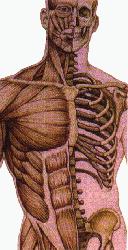
|
The structural system provides a framework for the body. Consisting of bones, muscles and connective tissues, it gives the body not only form, but also the ability to move.
When a baby is born, it has about 350 bones, all soft because they are composed mostly of a watery substance called cartilage. As the baby grows, calcium phosphate permeates the bones, and they stiffen. This process is called calcification. Eventually calcified cartilage is replaced by true bone, made up largely of calciumphostate, and some of the bones fuse together. A normal adult has between 206 and 209 bones in his body, depending upon whether he has one or two additional ribs and an extra bone in the coccyx (tailvone).
Calcium phosphate is deposited in bones in two ways. At the outer edge it takes the form of a solid, compact material covered by a membrane called the periosteum. Deeper inside, it becomes a honeycomb of spongelike, porous material called cancellous bone. A soft material known as marrow fills the spaces inside the cancellous bone. Marrow is actually the manufacturing site of both red and white blood cells, and as such is tunneled with vessels that move freshly made red and white blood cells out and bring in red ones containing essential nutrients.
Although bones generally stop growing in length during mid-teens for girls and at around age 20 for boys, they never really stop the growing process, because they are constantly rebuilding themselves. Bones contain two types of cells, osteoblasts and osteoclasts. These work together to continually build new bone material on the outside and remove old, unneeded material from the inside. To sustain this growth, the body must have sufficient supplies of certain nutrients including calcium, phosphorus and vitamin D. If there is a shortage of calcium in the bloodstream, the body will remove it from the bones without replacing it. This can eventually cause bones to become weak and porous. Unchecked, it can lead to a severely lifestyle-limiting, sometimes fatal condition known as osteoporosis.
Connections
Joints have been called masterpieces of engineering because they are designed to permit movement between bones that must meet, but not touch each other. Their role is to bind two or more bones firmly together while cushioning and lubricating them well enough to last through a lifetime of lifting, swinging, bending, walking, etc.
While their individual construction may vary, most joints are made up of connective tissue that secretes a liquid called synovial fluid. The synovial fluid lubricates the moving parts. Outside the capsule, fibrous anchors called ligaments surround the joint and link the bones. Ligaments protect the capsule and help keep all motion of the joint within safe limits. In places where muscle tissues, called tendons or sinews, pass nest to large joints so that muscles on one side will be linked to bones on the other, small fluid-filled pouches, or bursae, also act as buffers.
Muscles
Bones and sinews may control the movements of the body, but muscles create them by converting chemical energy from food into mechanical energy.
Muscles perform their work by contracting. This means that they pull, never push, and because of this it takes a pair of them to make a range of movement possible. There are more 600 muscles in the body consisting of three basic types: heart muscle, smooth muscle, and skeletal muscle. Each muscle is made up of innumerable tiny, stringlike fibers, and each of these, in turn, is composed of bundles of infinitesimal filaments varying in length from half and inch to about a foot. Small muscles have just a few fibers, while large ones have a great many.
Muscles grow strong through use. the effort it takes to use muscles makes the heart supply them with more blood and nutrients. This stimulates the growth of new muscle fibers and blood vessels. In effect, exercise enlarges and strengthens muscles just as it does bones.
Factors in structural health
Regular, lifelong activity is essential to deeping bones and muscles functioning optimally. If a person is never very active, his/her bones won't be able to grow as dense as nature meant them to be. Likewise, if a person is active enough to develop the strongest skeleton possible, but then becomes inactive, the bone that is no longer needed will eventually be lost.
Diet is also extremely important. As mentioned earlier, a shortage of calcium over an extended period of time can spell disaster. In fact, the loss of calcium is the most serious nutritional problem experienced by older Americans. boneloss appears to begin as early as age 35, and is particularly serious for women. As they approach menopause, their rate of bone loss accelerates greatly, partly because of a decreased secretion of the hormone estrogen, which helps maintain bone mass. An estimated 5 million women are affected by bone loss. Men, too, should be cautious, although the number of men experiencing serious loss is only about one-fifth that of women. The National Institutes of Health suggests that a daily calcium intake of a least 1,200 mg is required by adults. Because it is difficult to obtain that amount from food alone, and because some individuals may be allergic to the best dietary sources of calcium, supplementation is recommended.
Products for the body systems
|  The Structural System
The Structural System

 copyright 1999 -2002
copyright 1999 -2002